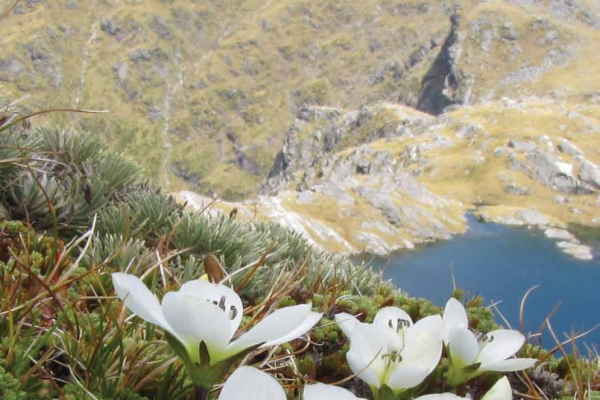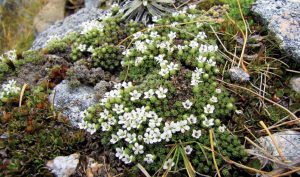The main divide in Fiordland separates the drier eastern ranges from the very wet western ones. In Part 1 of this article in the previous issue, travel was from the coast around Dunedin up to the main divide. On the western side we find extremely wet habitats with rainfall that can reach almost 300 inches a year!
At the divide, on exposed wind-swept ridges, cushions such as Myosotis pulvinaris, Raoulia hectorii var. mollis, Chionohebe ciliolata subsp. fiordense, and a very dwarf form of Gentianella bellidifolia keep each other company. These are beautiful cushion plants with similar growth habits and often grow into each other to such an extent that at flowering time when foliage is obscured, identification can be great fun.
Across the main divide into the wetter western peaks the glaciated U-shaped valleys are such a feature. Dracophyllum menziesii, a low- growing shrub with pineapple-like foliage, up to about a metre in height clothes the valley floors and the extensive herb fields can be a spectacular sight when the deep yellow blooms of Bulbinella gibbsii var. balanifera, the bold, stiff, spire-like stems of Aciphylla crenulata and the white flowers of Ranunculus lyallii on stems up to 1 metre (40 inches) tall are in full flight.
Further on up the slopes, stable rock is the habitat of one of the vegetable sheep, although this one, the trailing subshrub Haastia sinclairii var. fulvida, with its black-tipped bracts and pale yellow tomentum, does not make the woolly mounds of some of the others. Another plant here is Aciphylla congesta, which is commonly known as the snowball speargrass because of its crowded white flowerheads.
Up high, in and along the banks of running water, Ranunculus sericophyllus thrives. Not a large Ranunculus species by New Zealand standards, I find its deeply cut foliage, in combination with its bright yellow petals to be most attractive. Its stunning creamy colored hybrid with R. buchananii also grows nearby but I have never been lucky enough to catch it in flower. Fingers crossed for this next season maybe.
The near continental climate of the interior covers a number of ranges of northern Southland and is home to a great variety of plants. The new season's growth of Dracophyllum uniflorum var. frondosum, about 60 cm high (24 inches), gives almost an orange tinge to the alpine environment moderated somewhat by some outstanding large silver plants of Celmisia semicordata subsp. stricta.
This really is Celmisia country where some of the 50 species which reach the alpine zone reside, especially Celmisia verbascifolia, which is common with its midrib and petiole sometimes varying to purple.
If time is on your side you can spend many hours, as I often do, searching for a number of different hybrids that occur thereabouts or visit a low isolated peak named Mount Prospect where you find Celmisia traversii, with most plants having a distinct brown edge to their leaves and wonderful velvety brown indumentum on the underside of the leaves.
Elsewhere, in one small area, the rare Celmisia philocremna can be located. It has a preference for cool exposed rock bluffs and a number of years ago, I was lucky enough to be in a group of enthusiasts that found a small population outside its previously reported location. Almost succulent looking with thick slightly recurved leaves and large heads for the size of the plant, its flowers are well away from the hard cushion.
The green growths of Raoulia buchananii are also frequent in and around these bluffs and I love the way the tight cushions mould to the shape of the rocks they are slowly enveloping. The temptation to reach out and stroke them is so overwhelming.
The distinctive Aciphylla spedenii is there as well on the rock; however it is not recommended that you get too close as the leaves end in a very sharp tip, hence the common name of "speargrass".
Inhabiting steep extensive mobile screes where one quickly learns to sidle at a low angle to gain height, because to do otherwise means one step up equals two steps back , there are a number of specialized plants. These include the unusual-looking alpine chickweed Stellaria roughii, which sometimes carpets the rock floor so much so that it’s difficult to avoid stepping on it, and Ranunculus pilifera with its bright yellow flowers. I understand this buttercup has a growth pattern eventually reaching 1 metre across. That must be some sight as the plants I have come across have always been a lot smaller.
Finally in this survey of Fiordland plants I want to pick out a Myosotis species which is known unofficially as Myosotis sp. ‘Mossburn’ after the area in which it is found. This small alpine gem has white flowers typical of so many of the New Zealand Myosotis; however its extremely hairy foliage is certainly reason alone to try to locate and photograph it.
For those of you interested in learning more about the alpine flora and fauna of New Zealand, the recent publication Above The Treeline by Alan F. Mark is very highly recommended by the author. It received a very favorable review in the Fall 2013 issue of the Rock Garden Quarterly.


